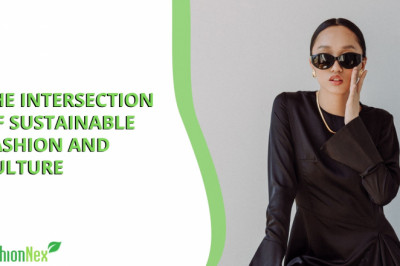views

Slow Fashion Movement: Embracing Quality Over Quantity
In an age where fast fashion dominates the market, the slow fashion movement has emerged as a powerful counter-trend that emphasizes quality, sustainability, and ethical production over rapid consumption. This movement advocates for a more thoughtful approach to fashion, encouraging consumers to invest in well-made, durable clothing rather than inexpensive, disposable items. As awareness grows about the environmental and social impacts of the fashion industry, the slow fashion movement is gaining traction, promoting a more conscious and responsible way of dressing.
The Rise of Fast Fashion
To understand the slow fashion movement, it's essential to first comprehend the fast fashion phenomenon. Fast fashion refers to the rapid production of inexpensive clothing in response to the latest trends. Brands like Zara, H&M, and Forever 21 have built empires on the concept of delivering the latest styles quickly and affordably. However, this model comes with significant drawbacks, including environmental degradation, exploitative labor practices, and the production of vast amounts of waste.
Fast fashion's emphasis on speed and low cost leads to the use of cheap materials and labor, often resulting in poor-quality garments that wear out quickly. This cycle of rapid consumption and disposal contributes to a throwaway culture, with clothing often ending up in landfills after just a few wears.
The Principles of Slow Fashion
In contrast, the slow fashion movement prioritizes sustainability, ethics, and quality. The core principles of slow fashion include:
-
Quality Over Quantity: Slow fashion encourages consumers to buy fewer, but higher-quality items. These garments are designed to last longer, reducing the need for frequent replacements.
-
Ethical Production: Slow fashion brands are committed to fair labor practices, ensuring that workers are paid fair wages and work in safe conditions. This ethical approach extends to all stages of the production process, from sourcing materials to manufacturing.
-
Sustainable Materials: Slow fashion emphasizes the use of sustainable and eco-friendly materials, such as organic cotton, recycled fabrics, and natural dyes. This reduces the environmental impact of clothing production.
-
Timeless Design: Slow fashion promotes timeless, versatile designs that can be worn for many seasons, rather than trendy pieces that quickly go out of style.
-
Transparency: Brands that adhere to slow fashion principles are transparent about their production processes, allowing consumers to make informed choices about the products they buy.
The Benefits of Slow Fashion
The slow fashion movement offers numerous benefits for consumers, the environment, and the fashion industry as a whole.
-
Environmental Sustainability: By prioritizing quality over quantity, slow fashion reduces the environmental impact of clothing production. Durable garments require fewer resources to produce and generate less waste. Additionally, the use of sustainable materials and production methods helps to minimize pollution and conserve natural resources.
-
Ethical Labor Practices: Slow fashion brands ensure fair wages and safe working conditions for their employees. This commitment to ethical production helps to combat exploitation and improve the livelihoods of workers in the fashion industry.
-
Cost Savings: While slow fashion items may have a higher upfront cost, their superior quality and durability mean that consumers spend less over time. Investing in a few well-made pieces that last for years is more cost-effective than continually replacing cheap, poorly-made garments.
-
Personal Style: Slow fashion encourages consumers to develop a personal style based on timeless, versatile pieces rather than chasing fleeting trends. This leads to a more cohesive and enduring wardrobe that reflects individual tastes and preferences.
-
Mindful Consumption: Embracing slow fashion fosters a more mindful approach to consumption, encouraging individuals to think carefully about their purchases and their impact on the world. This shift in mindset can extend beyond fashion to other areas of life, promoting a more sustainable and conscious lifestyle.
How to Embrace Slow Fashion
Adopting slow fashion principles doesn't require a complete wardrobe overhaul. Instead, it involves making thoughtful choices and gradually transitioning to a more sustainable and ethical approach to clothing.
-
Invest in Quality: Focus on purchasing well-made, durable garments that will last for years. Look for high-quality materials and craftsmanship when shopping.
-
Buy Less, Choose Wisely: Instead of buying numerous cheap items, invest in a smaller number of versatile, timeless pieces that can be mixed and matched.
-
Support Ethical Brands: Research and support brands that prioritize ethical production practices and sustainability. Many slow fashion brands are transparent about their processes and values.
-
Care for Your Clothes: Proper care and maintenance can extend the life of your garments. Follow care instructions, mend items when needed, and store clothes properly to keep them in good condition.
-
Secondhand Shopping: Consider buying secondhand or vintage clothing. Thrift stores, consignment shops, and online resale platforms offer a wide range of high-quality, pre-loved items.
-
DIY and Upcycling: Get creative by upcycling old clothes or making your own garments. This not only reduces waste but also allows for unique, personalized fashion choices.
Conclusion
The slow fashion movement is a crucial response to the detrimental impacts of fast fashion. By embracing quality over quantity, consumers can make a positive difference in the fashion industry, supporting sustainability, ethical production, and mindful consumption. As awareness of these issues continues to grow, the slow fashion movement offers a viable and appealing alternative for those seeking to align their values with their wardrobe choices.











Comments
0 comment